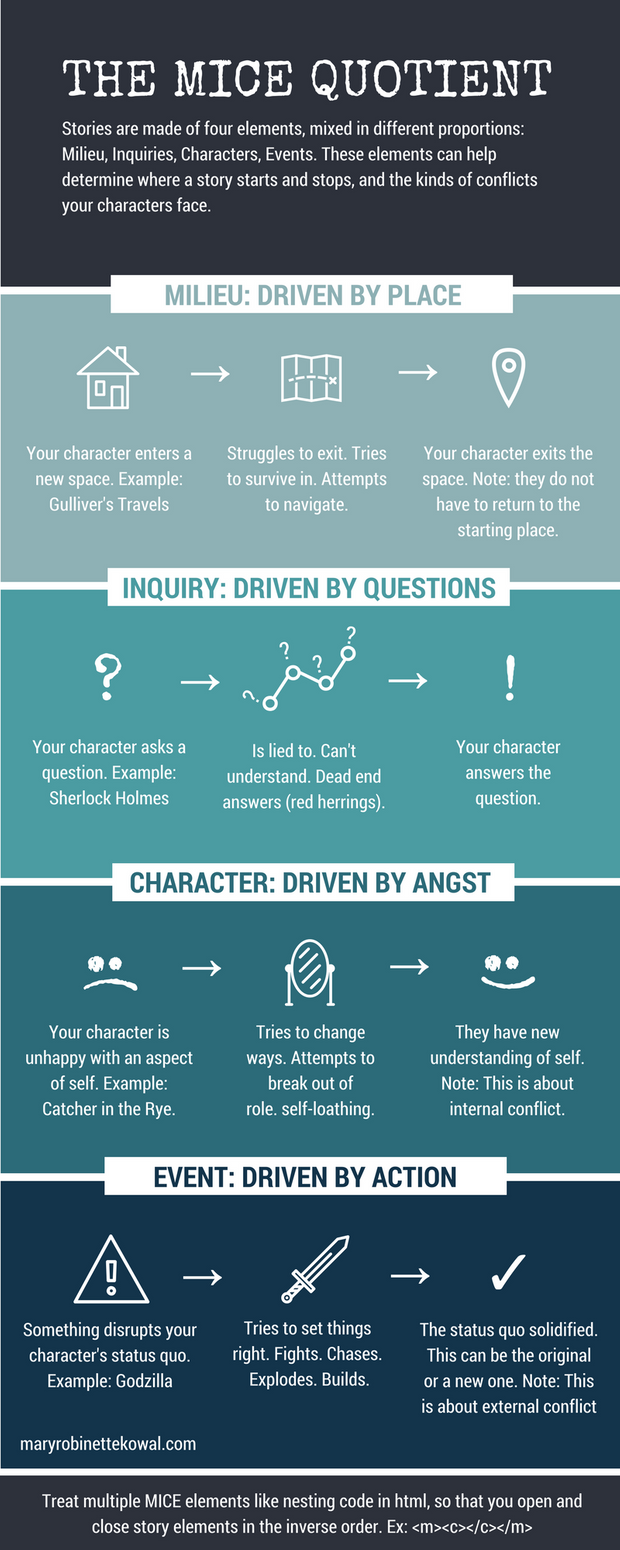MICE Quotient
Writer’s Toolbox

I’ve been thinking about what, besides blog posts, I want to include on here on my author page. As I’ve mentioned in my Next Chapters: Writing part 1, I have actively sought out learning opportunities around the topic of writing and life as a writer.
They say by teaching others, one can reinforce what they themselves have learned. So join me as I show off my writer’s toolbox, and take what you want, adapt anything and hopefully something I’ve learned can be incorporated into your own toolbox
MICE Quotient
My first introduction to the MICE Quotient was via an episode of Writing Excuses with guest) host Mary Robinette Kowal.
I’ve had the privilege to take a short story intensive course with Mary Robinette, where we got to apply this tool in our own work.
Mary Robinette created this awesome infographic highlighting the main points. (Text Version: http://www.christyshorey.com/wp-content/uploads/2020/02/The-MICE-Quotient.rtf) (My thoughts are below.)

My thoughts:
MICE stands for four types of driving forces you can find in stories.
- Milieu
- Inquiry
- Character
- Event
The type of story you are telling informs the central goals within the story arc, where it begins, what kind of conflicts prevent achievement of goal, and how it ends (either with the goal achieved, or not.)
How many arcs you have depends on the length and complexity of your story. As what drives us in life is never simple, the elements of the MICE quotient can be nested. Shorter stories will have one, maybe two elements.
- Milieu = m
- Inquiry = i
- Character = c
- Event = e
So, a story about Ash leaving home, then realizing the world is not how they thought it to be, which leads to a fundamental change in Ash before they return home would be a Character nested within Milieu story.
<m> <c></c> </m>
Longer stories will have more arcs that will open < > and close </ > as the story progresses it is important to note that a thread introduced within a larger thread must be resolved before the larger thread is closed.
<m> <c> <i> </m> </i> </c> does not work as the Inquiry and Character stories end after the outer story feels unsatisfying.
A more satisfying nesting of elements would be <m> <c> <i> </i> </c> </m>
A longer story will have many arcs of elements opening and resolving, some will last the whole book, others a chapter or two, and yet others as part of a scene.
If you are writing, and find the story is not working, or the ending feels off, be sure to check whether you left any elemental arc open or unresolved.
Chatting with Mary Robinette
I had the opportunity to speak with Mary Robinette at a writer’s workshop I attended last week about how she feels the MICE quotient has impacted her work, and what she would caution writers who want to use this particular tool.
Tell me about how the MICE Quotient has impacted your writing.
I learned it at Orson Scott Card’s literary boot camp. And it was the first time that I understood structure. I always felt like before that I would back into a story without understating what made it work, and that after that could do stories with intention, it helps me from having this thing where I had stories that had a good beginning, a good middle and a good end from three totally different stories that had the same set of characters. And now they match.
Mary Robinette Kowal at 2020 FutureScapes workshop
Do you have any words of cautions for individuals who may use the MICE Quotient as a tool in their writing?
It’s a tool, and it will return a certain type of story, and that it’s possible to break every rule, but you should think about doing it with intention. nothing is a cookie cutter
ibid.
